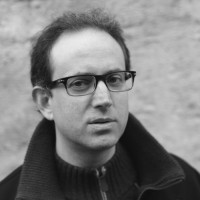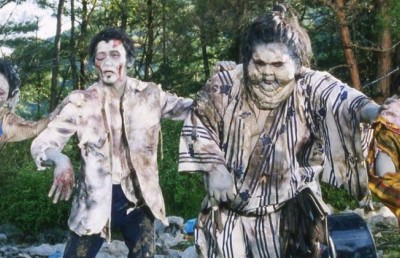Islands of Order, Part 1
Faust, Prog Rock, and the Politics of Scoring Clive Barker's The Forbidden
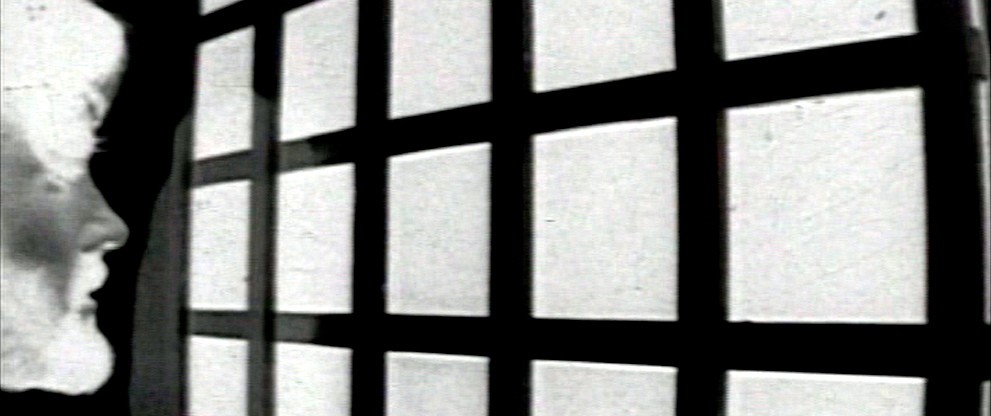
Nostalgia: Islands of Order in a Sea of Chaos
(or, why John Oswald should remix Godspeed You Black Emperor for Clive Barker’s The Forbidden)
(and, why Bill Laswell won’t remix King Crimson for the same)
Nostalgia. The floating remnants of cherished memories, doomed to being frozen in time while simultaneously being subject to constant reinterpretation through the experience of now. Islands of order in the sea of chaos that is the ever-changing structure of human memory. Taking bits and pieces of lived experience and grafting them onto the present unfolding, you could say that the mind samples itself to create an awareness that both responds to immediacy as well as to the vast reservoir of the past – so much folding of space onto itself to bring far moments near and to take the present on into the future. This extension of the life of memories through their re-contextualization in the present is the mind’s way of fighting against its own decay. Lest it be doomed to stagnate in the mire of neural gridlock, the flow of brain activity must continue, new pathways be forged, and the past always be open to re-contextualization according to contemporary understanding.
The struggle against decay that seems to be at the heart of humanity is the subject of a wonderful analogy made by guitarist Marc Ribot. He suggests that the inherent decay in the tone of a plucked electric guitar string might be one of the reasons that the instrument is so often equated with melancholy. “All guitarists fight this death,” he writes, “this logarithmic decline into silence, and its implied presence in every note…” (1). Ribot describes various defense strategies against the inevitable: the use of vibrato to lengthen each note; fast picking to cover the individual deaths of each; the use of sheer volume to reinforce the vibrations in the strings and increase sustain to the point of feedback. To struggle against decay and death is one thing, he says. “To try and win,” on the other hand, he describes as being a “Faustian error” (2). This is an interesting analogy for present purposes, as Clive Barker’s silent short film The Forbidden (1976) is a retelling of Faust, and will be the subject of a suggestion I will make about what music might best accompany it in the wake of Adrian Carson’s strikingly uninspired score for its 1998 Redemption DVD release.
The struggle to prolong life and the tactics devised to cheat death are indeed reflected in the tale of Faust, and can be seen not only in the technical practices of some guitar players but also in the manifestations their music takes over time. A particularly guitar-heavy branch of the musical world can be found in the vast sphere encompassed by the suggestive term “progressive rock.” Many have found their way through this realm; far too many to mention here. For this paper, four particular groups of musicians fitting somewhere within the sphere of progressive rock will be of interest. Different though they are, I will illustrate how King Crimson, The Grateful Dead, Miles Davis and God Speed You Black Emperor each, in their own way, take on the role of Faust journeying through the last several decades teasing, stretching and confounding progressive rock’s natural pattern of decay. By way of a little biomedical ethics, post-feminist gender theory, humanist musings about techno/human relations, and the copyright controversy surrounding contemporary sampling practices, certain progressive characteristics of the rock found in each of the four musical groups mentioned will be examined in light of the Faustian journey as interpreted by Clive Barker in The Forbidden. In so doing, the reasons why Barker’s film should have a score by one of these illustrious expounders of progress will become clear.
All things start to die as soon as they are born. This is the very nature of life. The natural process of decay and death is as natural as our attempts to deal with it through various strategies of regeneration. The idea that trying to cheat death is akin to signing away your soul to the devil is, of course, the subject of the Faust myth and is the source of the error Ribot refers to. Yet it seems to me that, in this increasingly secular corner of the world known as Western Civilization, the devil can be seen as an institutional imposition of fear onto the masses designed to keep people complacent in the status quo, and to keep us of the mind that any change in thinking might bring about the very damnation of our souls. Similarly, many of the suggestions made to us by people “in the know” about the ethical questions we face as a species grappling with death are no more than impositions from particular points of view, not dogmatic scientific truths about the nature of life.
At the heart of the matter is an understanding of what death is. For instance, as all you folks with organ donor stickers on your medical cards are (no doubt) aware, death in Canada is understood as the cessation of brainwave activity. Is this just a convenient way to compensate for the fact that the heart must be beating for organs to be effectively harvested? Given science’s admitted state of ignorance towards any complete understanding of the human mind, how can we really know what’s going on inside a person when their brainwaves simply no longer register on the equipment we have designed to measure them? This reliance on the state of measurement technology is especially disturbing when considering that this equipment was designed according to the limited understanding of the brain’s functioning in the first place. Science is constantly uncovering new and more minute details about life, the universe and everything – the Planck length as described by Stephen Hawking being a case in point (3). Yet neuroscience has decided that it has reached a high enough level of understanding about the most complex structure in the known universe that it feels justified in pulling the plug when it can no longer measure that structure’s activity. Our ears can’t measure sound above 20 Khz, but does that mean a dog can’t hear it?
I am reminded of the fact that it was once convenient to suppress women before the value of this sub-species of Man was measurable on a more modern yardstick. Or that it’s convenient to think that eating cats is unacceptable because they’re so cute, clean and fuzzy, while chowing on chickens is okay because they’re so “profoundly stupid” (4) I’m waiting for the day when the indisputable (from my perspective anyway) consciousness that exists in plant life becomes measurable and all of a sudden we realize that eating a carrot is far more ethically deplorable than carving up the more traditional dinner animals. But alas, I digress…
Euthanasia, of course, is another area where the ethics of cheating death are called into question. Is it not strange that there is such controversy over pulling the plug, when the person in question would be dead if there were no plug to pull in the first place? We seem confused, as a society, about what the difference is between acceptable efforts at the prolongation of life and “unnatural” attempts at cheating death. This confusion is no surprise, for these are murky waters indeed. And believe me, I do understand that we are forced to work at the limits of our own knowledge. Philosophical postulating cannot take precedence over the practicality of the matters at hand, lest we become so paralyzed with the myriad possible routes available to us that we end up frozen solid in an electric wasteland of supercharged panic like Hunter S. Thompson after one too many drops of adrenochrome (which, interestingly enough, needs to be extracted from the adrenal glands of a living human – “it’s no good if you get it out of a corpse”) (5). However, this being an essay of some philosophical extraction, I feel free to venture forth into the vast conceptual sea of struggle faced everyday between our own mortality and our inherent quest for regeneration. Not to worry, though, I will now move on from my little re-visitation of the glory days of Ethics 100 (though I make no promises that some other, equally useful, university intro courses won’t be making appearances here and there).
I bring up the issues of organ transplantation and euthanasia to call attention to the heated debates that surround issues of trying to thwart natural processes of decay through technological means. The same struggle between decay and regeneration exists in the comings and goings of musical eras. There are a number of strategies available for the Faustian seekers of the music world, and these strategies are as evident in the realm loosely defined as progressive rock as anywhere else. The very word “progressive” suggests a lack of stagnation over time in addition to the idea of breaking with the conventions of the moment. The music I would like to consider here fits both of these ideas of progression very well. I will not be dealing here with Mick Jagger belting out “I can’t get no…” exactly the same way now as he did 30 years ago, trying to freeze a moment in time as though he were an astronaut on a hyperspace mission, coming home the same age as when he left while everyone around him has become old and decrepit. Rather, the music at issue here demonstrates a constant awareness of its place in time, and evolves continually in rich interplay between where it started, where it is now, and where it is going.
As a starting point, I would like to illustrate the fact that one of the key links between the struggles against death in both music and on the hospital bed is new technology. Like medical efforts to stave off death for as long as possible, new fangled technologies often rear their ugly heads whenever musical evolution is at stake. Particularly pervasive these days is the technology of sampling, and it is no surprise that the act of sampling and the issues raised by that act are crucial to understanding the current place that progressive rock has in the world today. Interestingly, issues surrounding modern digital copying are almost as hotly debated (and spark similar levels of outrage) as the issues of euthanasia and organ transplantation. I believe this is, in part, due to the identification we have with the technologies of reproduction that we create for ourselves. Hillel Schwartz has this to say:
Acts and images of doubling start here, at the root of our lives: our flesh, our blood, our coming to be. In an epoch proud of instant copiers but perturbed by errant copies, delighted with lightweight artificial limbs but disturbed by the likelihood of clones, biology itself is invested with the rich ambivalence of myth. The stories we tell about our bodies, under the sign of the double helix, are as generative as they are genetic; we are said to begin, literally and originally, by making copies of our cells (6).
Schwartz is not the only one to have noted humanist tendencies to equate technological reproduction with the human body. Science-fiction is rife with such analogies, of course, but the idea that technologies of reproduction have a fundamental physical connection to humanity has been addressed on other fronts as well. Following McLuhans’s lead, media theorists like Friedrich Kittler and Jeffrey Sconce have explored early manifestations of reproduction technology and the humanist thought that surrounded them (7). Douglas Hofstadter even graces his Gödel, Bach and Escher with a graph illustrating one to one relationships between the processes of phonography and natural DNA replication (8). Additionally, recent events in the exploration of fractal geometry have gone far in suggesting that the act of copying may, in fact, be the fundamental principle guiding the universe. Suggesting that we may be hard-wired as human beings to experience life in terms of self-referencing and self-replication, artist Edward Berko offers this:
We find strange, unnatural connections between ideas. In this circulating rush, we postulate against originality. We posit the question: Are we in a condition of infinite repetition? Infinite self-similarity? Infinite magnification of differences which is actually the sameness we thought of as difference? We contemplate the search for order within sameness, order opposing sameness, order within random behaviour (9).
I’m not even going to get started on suggesting the doors that Berko’s words in this context open for a discussion of Deleuze’s concepts of difference and repetition as they relate to dissolution as an intrinsic part of Bergsonian creative evolution (10). Suffice it to say that the search for self-similarity within a seemingly infinite world of repetition and difference is at the heart of the concepts being considered here.
Berko’s art explores the aesthetics of fractal imagery (Fractal Images). This is an interesting and very relevant method of exploring the forms of nature through art. As fractal imagery is being increasingly thought of as a visual representation of the patterns of nature, to create an artistic expression of nature by studying fractal imagery suggests a new level of understanding. Perhaps this method of viewing nature could be embroiled within Baudrillard’s idea of the simulacra, trying to come to terms with something real by studying a copy for which the original never existed. However, the kind of multi-tiered referencing that Berko’s work illustrates is the hallmark of the digital era, and is no less valid than sitting in front of a real tree and trying to paint it. As Berko suggests, the mind seeks equivalencies everywhere. If such equivalencies can be found, must they not be able to teach us something about ourselves and our place in the world, regardless of if they were discovered by looking at an original or a copy?
Fractal geometrician Michael Barnsley has found a practical application for the theory that the universe operates on principles of self-similarity and regeneration through the act of copying. His fractal image compression system involves a way of creating digital images capable of infinite levels of resolution. The program is designed so that, when any given portion of the digital image is blown up, it copies little bits of itself over and over to recreate the detail that would ordinarily be lost as the pixels in a regular picture get larger. He came upon this method after toying with his collage theorem, whereby the creation of computer generated images that look organic are created by taking basic forms, then layering these forms with tiny little copies of themselves. “The theorem said: if you took a fern and covered it with little ferns then you would have created a dynamical system, or formula, for a fern” (11). Barnsley’s genius was to create a program that can find the formula for any given shape, thereby creating a program that can generate images of organic forms without human intervention. The key lay in the collage of the forms with copies of themselves. This is very much like what we see out in nature: things that look similar yet are all different – infinite repetition within infinite difference.
So, Barnsley’s project is to cheat the decay and death imposed on traditionally generated images by the basic unit that makes up visual images: the pixel. Through the creation of self-replicating digital images that literally copy themselves in ever greater amounts of detail to provide infinite levels of resolution, fractal image compression systems are indeed a sign that they key to infinity lies in the act of self-referencing. Most remarkable it that he developed this system by observing organic forms. Could it be that nature itself has designed us humans not only to reproduce in the form of offspring, but also to reproduce our own thoughts and actions over and over again to create ever-greater levels of thought resolution? Is there some hardwired pleasure in the process of copying? As Sri Aurubindo suggests:
What, you ask, was the beginning of it all? And it is this… Existence that multiplied itself for sheer delight of being, and plunged itself into numberless trillions of forms so that it might find itself innumerably (12).
Maybe that’s why, for me, knowing there is a CD in the burner is often just a satisfying as it is to listen to the finished product, like the smell of baking bread long before the first slice is cut.
Many would love to pull the plug on our ability to make perfect copies of recordings at will. From Napster to high definition television broadcasts, senators and congress people have been busy for years trying to sort out all the hubbub over the control of copying. Perhaps, in the age of computers on nightstands, Trudeau’s adage that the government has no place in the bedrooms of the nation might well be applied to the issue at hand. Is it because, for the first time in history, the technologies of reproduction have brought us so close to what transpires within our physical selves that the act of copying becomes intertwined with the myths we create about transgressing the sacred site of the body (and the damnation such transgression is said to bring)? Or perhaps the biology that Schwartz suggests “is invested with the rich ambivalence of myth” (13) is in danger of losing this mythological ambivalence and becoming, for whatever it’s worth, full blown scientific fact. Apparently such movement from myth to fact is worth billions.
The issues raised when considering the biological implications of digital sampling suggest that, as has always been the case, new technology teaches us more about ourselves than we usually care to admit. In this case, sampling technology mirrors efforts on the medical front to escape natural patterns of physical decay. As I suggested, such escape from patterns of decay is also visible in the world of progressive rock music. No surprise, then, that sampling technology has also played a key role in the evolution of this musical species. The tendency to infuse the theoretical issues raised by sampling with a corporeal twinge illustrates the key focal point of this paper: as human beings, that which we create is unavoidably connected to our experience as physical entities. This is where the analogy of Faust’s error is particularly apt: his mistake is one of trying to avoid his physical imperative as a human being. So, the Faustian error that Marc Ribot refers to is at the heart of the various areas that I am trying to merge here: physical decay, reproduction technology, and the evolution of a musical species. Having somewhat developed the analogy of the Faustian error as it relates to issues in medical ethics and digital copying, it is now time to look at an example of how Faust himself has been interpreted using the idea of corporeality as it relates to technologies of reproduction. An analysis of Clive Barker’s short silent film The Forbidden will provide a concrete example of an artistic exploration of Faust’s relationship to the theoretical issues explored thus far. This analysis will also provide the perfect bridge into a discussion of how Faust’s plight can be seen at work in the realm of progressive rock, a brand of music that, coincidentally enough, would provide the perfect musical complement to Barker’s film.
In The Forbidden, Barker’s concern for the corporeal aspect of Faust’s journey to immortality is particularly striking and, as we will see, brings up many issues at work in all the recording arts be they text based, auditory or visual. The Forbidden features a man apparently obsessed with a large pictograph. Tearing it up, he then proceeds, over the course of the rest of the film, to reassemble the pieces like a jigsaw puzzle, until it has finally been reconstructed whereupon the pieces are blown away for all time.

As he puts the pieces together one by one, he passes through various phases: first the voyeuristic observation of a couple engaging in sexual activity; then the tattooing of his own body with the same markings found on the pictograph; another observation of a sexually aroused man dancing frenetically; and finally, the removal of his own marked skin revealing what lies beneath. Barker’s Faust, in many ways, prefigures Greenaway’s The Pillow Book (1996), itself a lush treatise on relationships between contemporary sampling and age-old interest in text mediated by the human body. Greenaway’s film explores one of the oldest of recording technologies, the calligraphy brush, in the context of a visual aesthetic more in line with a windows-based PC operating system: pictures within pictures, folding time and space like a journey through the hypertext of the protagonist’s memory as she tells the story of her own obsession with the printed word. Her lover is murdered, his skin peeled, inked, and sewn into a book, the ultimate joining of human flesh with the first great technology of mass reproduction. This book of human flesh also illustrates an extreme form of fighting the natural decay of the human body. Greenaway is certainly no stranger to interest in corporeal decay (as anyone who has seen A Zed and Two Noughts (1985) is surely aware). Finally, the protagonist of The Pillow Book ends up by permanently marking her own flesh through extensive tattooing.
In the context of Greenaway’s visual treatment, this marking of the flesh reflects an attempt at reconciling reproduction technology with the human body. The inscription of reproduction technology onto the body, which both reproduces and decays, is akin to the struggle for immortality faced by Faust. The Pillow Book ends with the protagonist coming to terms with herself and her place in her world by permanently embracing, through tattooing, that which had only been fleeting for her up to that point: the printed word. Barker’s tattooed man, however, finds release only when his marked surface is removed, as though embodying what Frederic Jameson would later come to argue as being the importance of depth beneath surface (14).
In some respects tattooing can be seen as a commitment to the joining of surface with depth for as long as the body lives. In other respects, tattooing can be seen as the penultimate act of embracing surfaces, calling attention away from the depth below it and deflecting the historicity of the body in favour of its ornamentation. It can go either way, as can any number of arguments for or against the struggle against mortality. Should a guitarist turn up his amp to prolong the decay of the dying expression unleashed beneath the fingers on the fret board? Or should the plug be pulled like so many guitarists renown for their electrically charged loudness (Clapton, Townsend etc.) have done in more recent years?
The Forbidden addressed the plight of postmodernity before postmodern discourse emerged as the framework of choice for the analysis of everything from social culture to bacterial culture. The Forbidden is about blurring boundary lines, exploring intersections in consciousness, and the processes of deconstruction and reconstruction on both literal and metaphorical levels. Barker’s film is based around the image of the pictograph reduced to fragments followed by its reassembling. This breaking down and rebuilding of the image is placed in the context of the protagonist coming to terms with his own body and sexual identity. Attempting perhaps to recapture the unity of the pictograph after its destruction, he has similar markings tattooed onto his flesh, directly addressing the idea of wholeness as it relates to an individual body. This idea of whether or not an individual can be a whole being is further explored in the context of his sexual identity as he is confronted with sexual acts carrying both hetero and homosexual connotations. Finally, the removal of his outer flesh at the end of the piece calls to mind the idea of “being at home in one’s own skin.” Can a body exist as an autonomous being simply because it is packaged in a seamless wrapper? Or is the fluidity of identity espoused in much postmodern gender theory being expressed literally as a body being freed by the removal of its misleading packaging?
The growing popularity in celebrating the breaking down of biological constraints through the use of cosmetic surgery is also addressed here. Having one’s skin removed to free the person within is akin to various other surgical procedures that can be used to fight against the images of the bodies we have been given. The state of the theory, however, is unfortunately not in line with the practice. I fully believe in breaking down the social constraints of gender codes and sexual taboos. I believe, though, that this can be done in ways that respect the bodies we are born into. Mind you, I’m all for the art of tattooing, and couldn’t the pleasant effects of exercise also be seen as the changing of our bodies from their natural states? So once again, where do we draw the line? Is the surgical alteration of a birth defect to conform to social norms really any different from surgically altering a person’s genitalia to fix the defect of being born the “wrong” sex?
In “Choosing Disability,” Laura Hershey talks about the Independent Living Movement, the disability community’s civil rights movement. She writes: “Instead of locating our difficulties within ourselves, we identify our oppression within a society that refuses to accommodate our disabilities. The real solution is to change society…” (15). One of the key issues she addresses is the use of language to perpetuate the social ills that refuse to accept people with disabilities: “Language reinforces the negativity….Many of us have been called ‘abnormal’ by medical personnel, who view us primarily as ‘patients’ subject to the definitions and control of the medical profession” (16). This kind of social categorization and oppression of minorities is part of the problem that Gordene Olga Mackenzie sees when addressing the issue of transsexualism in America. In “Transsexualism in America” the author explains that the focus of gender identity and sexual preference being trained on biological sex has been a paradigm that contributes to the idea that transsexuals are in the “wrong” body (17). This paradigm is achieved largely through the rigidity of our language and its limited capacity for categorizing the physical world. MacKenzie speaks of some Native American tribes which accept the idea that there is a spiritual dimension to gender that transcends the biological imperative (18). In “The Two-Spirited,” Terry Tafoya explains that many genders other than male or female are recognized by Native cultures, and that this recognition is built right into 168 of the 250 or so Native languages still spoken in the U.S. (19). In addition, Tafoya notes that terms like Gay and Lesbian are being resisted by Native Americans as they do not wish to be categorized according to binary opposition. Instead, the term “two-spirited” is being adopted to accommodate the fluidity of gender and sexual roles that aren’t allowed by languages like English (20). It is important to recognize the role that language has in building our world and the way we live in it. Tafoya suggests that a change in our modes of representation through the languages of expression, including film, must be made.
In her analysis of Jenny Livingston’s Paris is Burning, a documentary about a group of drag queens, Jackie Goldsby examines the importance of the use of language by the filmmaker and her subjects as a tool in breaking down the boundaries between gender roles. She notes: “The film unfolds conceptually, initiating visual understanding of the culture through its linguistic signifiers” (21). With its use of title cards to put forth words which the film then explores in the context of drag queen ball culture, Goldsby describes Paris is Burning as a kind of “talking book” and compares the film to Raymond Williams’ language historiography Keywords. She writes: “Williams attributed language’s slippery fix on meaning to its subjection to political contexts. Paris is Burning projects a similar critique, specifying the body as both subject to and the instrument of re-vision because of its (dis)engagement with commodity culture” (22). In Goldby’s assessment, Paris is Burning is a site where the relationships between body, language and text meet through the art of filmmaking in order to illustrate how these relationships result in a fluidity between constructed boundary lines. The film’s final title card is of special significance in Goldsby’s eyes: “the words ‘PIG LATIN’ – the dissimulation of language by reversing the pronunciation of words – signal that we can’t know this world fully. Levels of signification and understanding amongst the children remain that, like their bodies, defy translation” (23). Indeed, language alone offers a very limited possibility for understanding the world, yet we tend to rely on it as the very foundation of our experience. No surprise, then, that people interested in moving beyond the confines of language would use it in a subversive way, reversing its intended order and thereby exploding the rigid confines of its meaning.
The idea that the body is a text is crucial in postmodern gender theory. Jacquelyn N. Zita notes that “postmodernism brings into focus first of all the ‘locatedness’ of one’s body as a place from which particular viewpoints on reality can be generated” (24). The understanding of the body as a text that can be manipulated to conform to a variety of different perspectives is at the heart of contemporary notions of fluid identity. She writes: “The subject becomes a product of discourse or intersecting textualities, as the world becomes a ceaseless play of interlocking and conflicting texts, spoken from different locations and negotiated across different perspectives” (25). Film would seem to be the perfect medium for exploring postmodern perspectives on the body and its capacity for fluidity. Intertextuality is a staple concern in the realm of film studies. As a medium most often based on montage and motion, film is an exploration of fluidity within the context of intertextuality. Whenever an edit is made, a simultaneous collision and merging between two shots is created. At some level, each shot can be considered a text, and the constant relationships drawn between these texts through editing is really an exercise in sorting out a rich interplay of differing texts. If we find a homogeneity throughout a given film, it is only through our capacity to remain fluid through an ever changing sea of intertextuality. I believe this capacity for remaining fluid is what makes film possible for us, a kind of psychological version of the physical effects of the phi phenomenon and persistence of vision that allow a series of still images to be interpreted as unbroken motion. Also, as the structuralists discovered, film resists being reduced to the confines of a single linguistic system. It has elements that allow some common interpretation, but is ultimately subject to the varied understandings brought by individual viewers.
Certainly, Clive Barker’s The Forbidden and Peter Greenaway’s The Pillow Book play with film’s status as an inherently intertextual medium and its resultant potential for exploring postmodern notions of the body as a fluid entity. Both films also explore the relationships between text, language and body through key issues raised by contemporary sampling technology. The way film is constructed in the editing room is very much related to the way that sample-based music is put together. In fact, it is my belief that contemporary DJ music and sampling techniques have been greatly influenced by the art of filmmaking. It makes perfect sense to me that creating music through the arrangement of samples has come at a time when the understanding of music as being a compositional and melodic organization of sound is dying, with a more holistic understanding of sound taking its place. Creating sound for film has long been the art of taking bits and pieces of pre-recorded sound and arranging them according to a logic of space rather than the logic of Western compositional standards of musical form. Jackie Goldsby mentions that, in Paris is Burning, the ball world of the drag queens is deeply immersed in intertextuality, the queens drawing on a rich repertoire of historical identities in order to reinterpret them according to contemporary understanding and break down the confines of historical categorizations. She suggests that “the ball world recycles commodity culture, much as rap music samples from the musical gene pool” (26). Just as Schwarz suggested earlier, our ideas about genetics are laden with reproduction technology as a main reference point. Goldsby’s use of the term “gene pool” to describe the sources that rap music draws upon suggests that DJs remix more than just records: they remix life itself according to contemporary notions of physical and psychological intertextuality of identity. So, the layers come together. The art of sampling is directly related to a growing mythology surrounding our very natures as human beings and the relationship between our outer physical appearances and our place in the world at large.
In the case of The Forbidden, Barker explores the concept of intertextuality through sampling as it relates to issues of identity and the body in several ways. To begin with, the film is a reinterpretation of the Faust myth, and as such embodies one of the most basic forms of intertextuality: taking a historical source and subjecting it to a new understanding through its recombination with other textual sources. Another text cited is present in the final sequence. After having his skin removed, the protagonist is presented with his organs and veins visible. This effect is achieved by painting these innards onto the actor’s flesh, reproducing Vesalius’ classic studies of human physiology. So, a classical historical understanding of the human body is referenced, but placed in the context of new ideas about the body as it relates to identity.
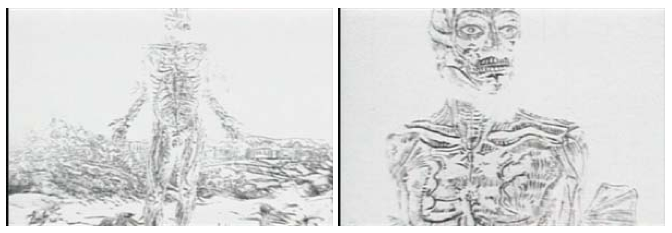
The protagonist’s skin is removed only after he transposes the pictograph to his own flesh. This transposition can be understood as another kind of sampling, this time through express usage of reproduction technology: the tattooist’s needle.
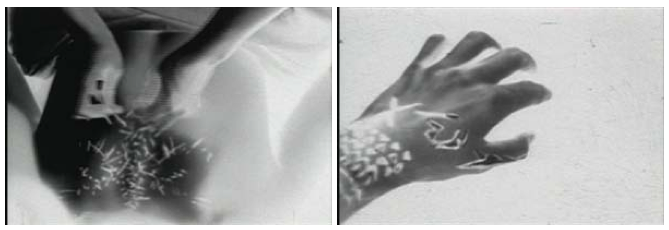
The pictograph itself suggests a language that can only be understood by breaking it down into pieces and then reassembling it. This breaking down and rebuilding is yet another act of sampling whereby pieces of the whole are isolated from one another and gradually reassembled through the wisdom of new experience as the protagonist shifts through various phases of self-understanding.
Finally, the body is placed in the context of other natural organic forms through the juxtaposition between twirling branches and the spinning dancer that occurs in the sequence featuring the sexually aroused man dancing frenetically.

This juxtaposition calls attention to the fact that the body is part of a larger system, and shares relationships with that system. As I mentioned earlier, studies in fractal geometry have suggested that nature reproduces itself through acts of self-sampling, which is why we can find bits of ourselves everywhere in the world from the tiniest microbes to the largest galaxies. This idea of self-replication throughout nature fits very well with the idea of the body and personal identity not being fixed to any one thing, but fluid and able to move through any number of different constructs. We are all part of the same thing; we can find ourselves everywhere and so do not need to remain stagnant with any one view of ourselves and our place in the world.
In The Forbidden, the Faust character moves from phase to phase through two distinct visual manifestations of borderlines. The first is a window with crossbeams carving it into a series of smaller portals. The second is a block of wood sporting a collection of precisely placed nails. The freedom that exists beyond each is represented in different ways. For the window, there appear recurring flocks of ravens fluttering just beyond his reach.
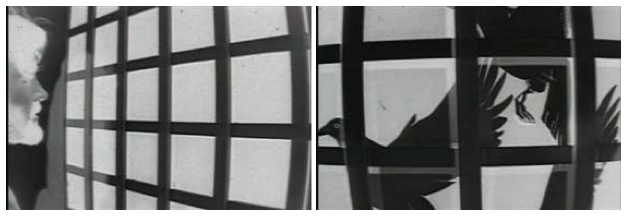
In the case of the nails, they are filmed with a moving light so that the shadows they cast drift around the board in a circular fashion, ostensibly suggesting the fluidity of borderlines in the light of shifting perspective.

These nails would later return imbedded in the skull of Pinhead for Barker’s Hellraiser (1987). In this later film they would also be placed in the context of fluid identity. Gracing the master of the Cenobites, whose mission it is to bring humans to the liminal spaces between pain and pleasure where the two meet in indistinguishable ecstasy, the transgression of borderlines suggested by the nails is clear. Interesting to note that the puzzle box used to summon the Cenobites, something of an exotic Rubik’s Cube, is a model of shifting context, an object that begs to be constantly reworked in search of pleasurable combinations of possibility. It also recalls the pictograph in The Forbidden with its emphasis on reassemblage.
The collision of pain and pleasure brought about by the shifting structure of the puzzle box is evocative of the potential unleashed by sampling technology, so often used to reassemble sonic materials to create new hybrids of indistinguishable moments. Sampling’s capacity for intertextuality is the key to its conceptual relationship with postmodern ideas about fluid bodies and fluid identities. Intertextual reinterpretation through sampling is also a way of fighting against the stagnation and decay of rigid constructs that keep texts in isolation from one another. Fractal geometry suggests that nature doesn’t keep things separate, so why should we impose the confines of language and categorizations on our own experience? However, we are far from any ideal of complete deconstruction, and after we have completely deconstructed, where do we go from there? Can we really exist as completely fluid beings? The struggle, it seems, must continue between maintaining our individuality and yielding to the flow of our place in the bigger picture.
Notes:
1 – Ribot, Marc. “Earplugs.” Arcana: Musicians on Music. John Zorn, ed. New York: Granary Books, 2002: 234.
2 – Ibid: 235.
3 – Hawking, Stephen – interviewed by Arthur C. Clarke in: Colors of Infinity. Nigel Lesmoir-Gordon, dir. A New Moon and Gordon Films Production, 1994.
4 – For a mesmerizing discussion on the profound stupidity of chickens, listen to Werner Herzog’s commentary track on the DVD release of Even Dwarves Started Small.
5 – Thompson, Hunter S. Fear and Loathing in Las Vegas. London: Paladin Books, 1976: 123
6 – Schwartz, Hillel. The Culture of the Copy. New York: Zone Books, 1996:19.
7 – See Kittler, Friedrich A. Gramophone, Film, Typewriter. Geoffrey Winthrop-Young and Michael Wutz, trans. Stanford: Stanford University Press, 1999; and Sconce, Jefferey. Haunted Media: Electronic Presence from Telegraphy to Television Durham: Duke University Press, 2000.
8 – Hofstadter, Douglas. Gödel, Escher, Bach: An Eternal Golden Braid. New York: Basic Books, 1999: 536.
9 – Edward Berko in: Briggs, John. Fractals: The Patterns of Chaos. New York: Simon and Schuster, 1992: 168.
10 – Pearson, Keith Ansell. Germinal Life: The Difference and Repetition of Deleuze. London: Routledge, 1999: 81.
11 – Michael Barnsley interviewed in: Colors of Infinity. Nigel Lesmoir-Gordon, dir. A New Moon and Gordon Films Production, 1994.
12 – Sri Aurubindo quoted in: ibid.
13 – Schwartz, Hillel. The Culture of the Copy. New York: Zone Books, 1996: 19.
14 – Jameson, Frederic. “Postmodernism and Consumer Society.” Postmodernism and its Discontents. E. Ann Kaplan, ed. London: Verso, 1988.
15 – Hershey, Laura. “Choosing Disability.” Ms. Vol. V, No. 1, 1994: 29.
16 – Ibid.
17 – MacKenzie, Gordene Olga. “Transsexualism in America.” Transgender Nation. Bowling Green, OH : Bowling Green State University Popular Press, 1994: 14.
18 – Ibid.
19 – Tafoya, Terry. “The Two-Spirited.” Ethnic and Cultural Diversity Among Lesbians and Gay Men. Beverley Greene, ed. Thousand Oaks, Calif: Sage Publications, 1997: 4.
20 – Ibid: 5-6.
21 – Goldsby, Jackie. “Queens of Language: Paris is Burning.” Queer Looks: perspectives on lesbian and gay film and video. Martha Gever, Pratibha Parmar, John Greyson, eds. New York : Routledge, 1993: 110.
22 – Ibid: 110-111.
23 – Ibid: 111.
24 – Zita, Jacquelyn N. “Male Lesbians and the Postmodernist Body.” Hypatia. Vol. 7, No. 4 (Fall 1992).
25 – Ibid.
26 – Goldsby, Jackie. “Queens of Language: Paris is Burning.” Queer Looks: perspectives on lesbian and gay film and video. Martha Gever, Pratibha Parmar, John Greyson, eds. New York : Routledge, 1993: 111.

